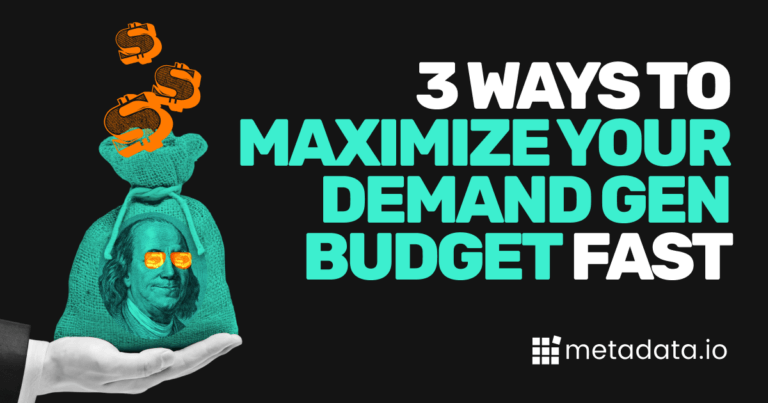How to Double Your Pipeline With the Double Funnel
ABM this. Demand gen that.
We’re here to tell you there’s a time and a place for both. And the best B2B marketers are actually running both.
What’s the right mix for your company?
That’s where the double funnel from TOPO, now Gartner, comes in.
Let’s take a quick spin through some fundamentals, then we’ll explain what the double funnel is and how you can use it to find — and continually improve — an optimal mix of account-based marketing and demand generation.
- What is account-based marketing?
- What is demand generation?
- What the heck is account-based strategy?
- Which tactics are which?
- Align ABM and demand generation with a double funnel
- A real look at the double funnel
- Dig deeper to improve performance across the board
- How to find the right balance
- How to address the obstacles
Rather watch the video?
Busting out some buzzwords
Marketers have never been known to create buzzwords, right?
Haha, jk, jk.
Here’s the thing, friends. There’s no shared definition for these terms:
- Account-based marketing
- Demand generation
- Account-based strategy
Ask eight different marketers, and you’ll probably get eight different explanations for each of them. But there are some generally accepted principles that we can use to frame this guide and our recommendations.
What is account-based marketing?
Account-based marketing (ABM) is all about identifying and marketing to a specific number of high-value accounts based on their likelihood to have success with your product. In other words, you create a list of target accounts where you have an unfair advantage with your technology differentiation — and therefore a much higher rate of success.
Identifying these top accounts goes beyond outlining your ideal customer profile. You need to incorporate all kinds of data and intelligence so you really understand who your absolute best prospects are.
Then you take these prospects on a full-funnel journey from high-level thought leadership content (TOFU, anyone?) down to low-level, reasons-to-buy content (the meaty BOFU content).
ABM is particularly helpful when you have a more complicated sale or set of problems you’re solving, and your average sale price (ASP) is high — which means you’re taking these accounts through the entire journey over months to years.
What is demand generation?
Demand generation is an umbrella term that includes many tactics and activities designed to create demand for your product or category. “Demand” is a desire for a particular commodity. Generating demand is therefore about making your product or category desirable to potential buyers.
With this in mind, we think of demand gen as basically everything you do as a marketer—from making your product better than the competition to making it clear how people can get value from that product.
But the generally accepted definition of demand generation is that it’s the higher-volume, lower-ASP counterpart to account-based marketing.
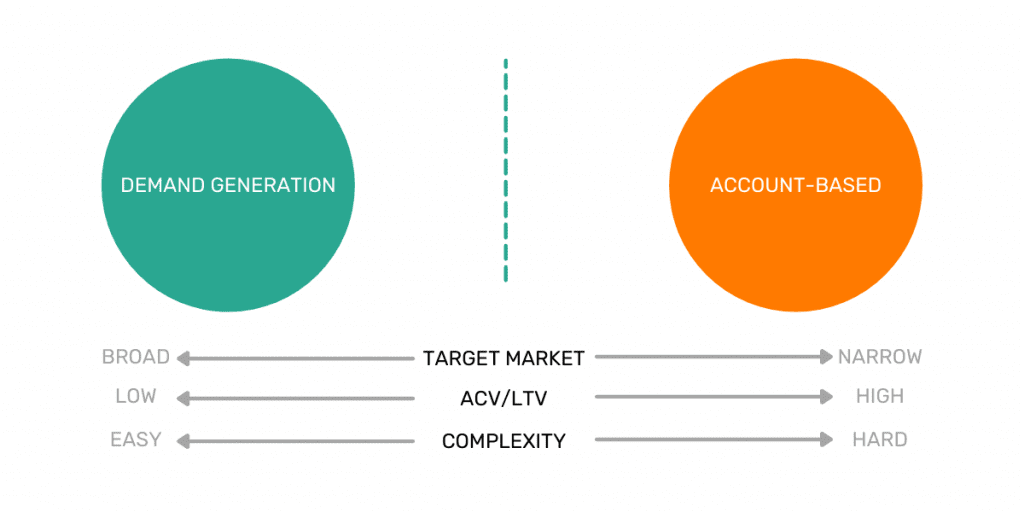
And what on earth is account-based experience?
Wanna make things even hairier? We’ve got a third term for you: “account-based experience”.
Account-based experience (ABX) is the coordination of valuable, relevant experiences, delivered across all functions, to drive engagement and conversion at a targeted set of accounts.
This term has evolved out of the misconception that ABM is primarily a top-of-funnel strategy focused on targeted advertising. If you want to be successful with ABM, you must take a full-funnel approach and stretch right on through to sales.
So, “account-based experience” is a bit of a dramatic overcorrection to make sure we’re talking about an integrated approach between sales and marketing that includes the entire funnel.
ABM vs. demand generation — which tactics are which?
This is sort of a trick question.
There are some tactics that fit clearly into the demand generation bucket or the ABM bucket:
- Activities that are geared towards understanding account intent, scoring and prioritizing accounts, and taking individual buyer prospects through a journey skew toward the ABM category.
- Activities that allow you to capture existing demand using broader, volume-based advertising tactics using your first-party data skew toward the demand gen category.
But what about the rest?
Most of the activities you’ll do in marketing can be applied to both ABM and demand gen, depending on how they’re used.
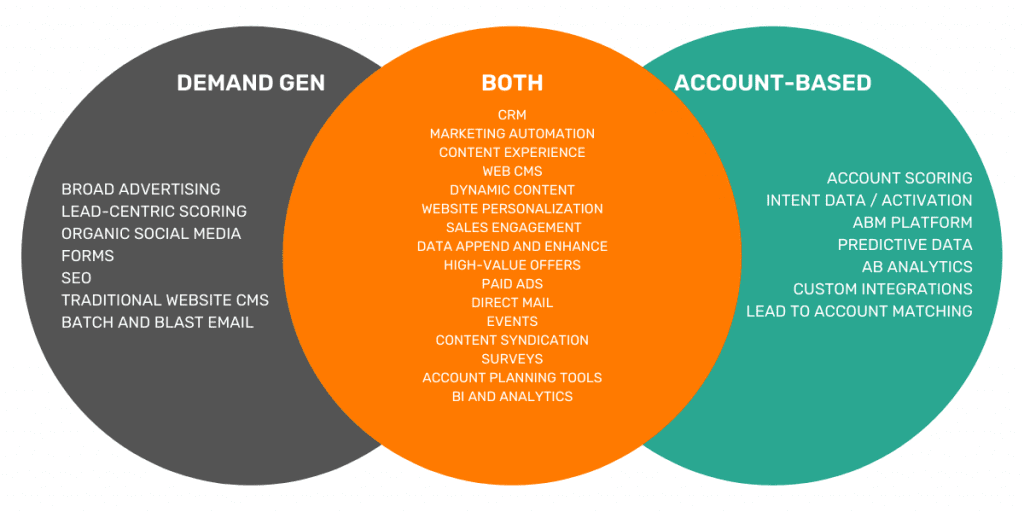
- Take events, for example. They can be used to build new relationships (demand gen). But sales may be required to book a certain number of meetings with key accounts during the event (ABM).
- How about podcasts? Sharing thought leadership through a podcast is generating demand. You can also use your podcast as a way to break into key accounts (invite them on the show!).
- ROI calculators. If you have the right data to offer people a decent read-out on what it might be like to work with your company (no one wants to hear you’ll save them $8 bajillion per year), this can be a great demand gen tactic. But you can also do some deep research on target accounts to start working through the calculator for them (a personalized cost-savings report is a great conversation starter).
- Guides, reports, yadda yadda. Got internal data? Publish it a la Gong for demand generation (Gong produces phenomenal, data-driven guides all about improving sales but using AI to weed through real sales calls). You can also pitch a compelling point or two from this amazing guide into a 30-minute conversation with key accounts.
At the end of the day, you can make almost anything you do in marketing work for any go-to-market — it’s all about how you execute.
Speaking of execution…
Align ABM and demand generation with a double funnel
Okay, so you’ve been doing a bunch of traditional demand generation stuff, and your team has decided to add some account-based marketing.
You nail that account list and start going to town — and then you measure everything the same way you always have. You use the same benchmarks you’re used to from demand gen (e.g. MQLs) to judge how well your ABM programs are going.
Womp, womp.
You’re not alone. Most marketers running account-based programs try to measure them using a traditional lead model.
The truth is that your demand gen efforts and your ABM efforts will probably look wildly different from your demand gen programs in terms of:
- Volumes
- Conversion rates
- Behaviors
So, benchmarking ABM and demand programs against the same metrics doesn’t make any sense. But measuring your ABM against an entirely new set of metrics means you can’t easily compare your performance apples to apples.
This makes it tough to tell a connected story about your go-to-market strategy.
What’s a marketer to do? Never fear, the double funnel is here.
The double funnel can be represented by a pretty simple graphic, but that’s all it took to inspire an epiphany for us.
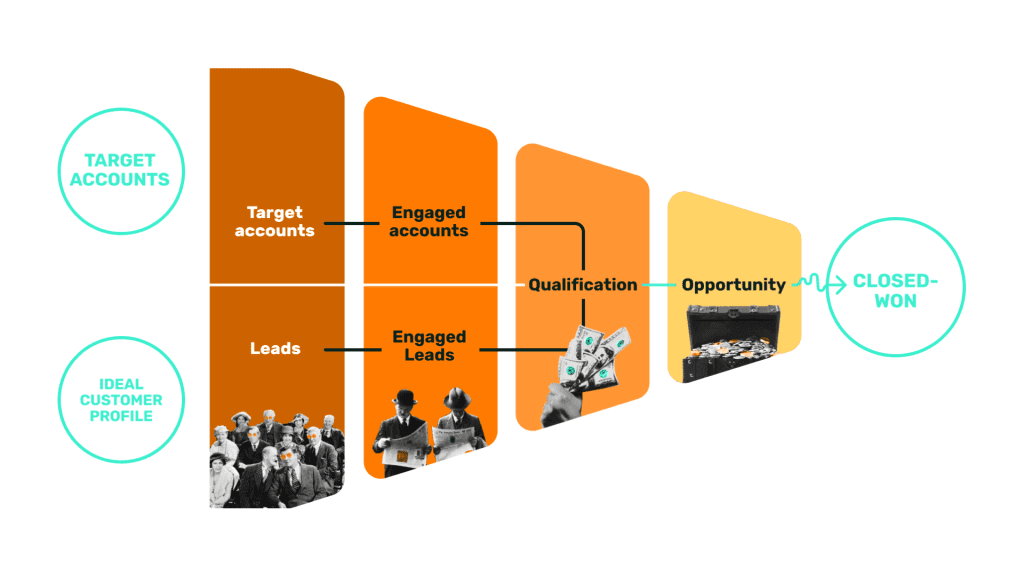
Thinking about your marketing efforts in terms of the double funnel gets your head in the right place to:
- Align all of your go-to-markets
- Measure everything accurately throughout the entire funnel
It’s not sexy. It’s not rocket science. More like simple brilliance.
The double funnel allows you to visualize your ABM and demand gen efforts side-by-side, aligning the account-based funnel with the traditional marketing funnel. Then you can see progress through each side of the funnel stage by stage and easily compare performance.
Note: Your funnel doesn’t have to end at closed-won (in fact, it probably shouldn’t). Closed-won just served as an easy benchmark for us in this double funnel visualization. The best ABM strategies go beyond acquisition right through the rest of the funnel.
A real look at the double funnel
Let’s take a look at how this double funnel comes together with some actual data. These are real benchmarks for high-growth SaaS companies from Gartner, placing ABM performance metrics alongside demand gen metrics.
Of course, your own data will always be more valuable than benchmarks. These are some of the fastest-growing companies in the world, so don’t get discouraged if your numbers don’t look quite so rosy.
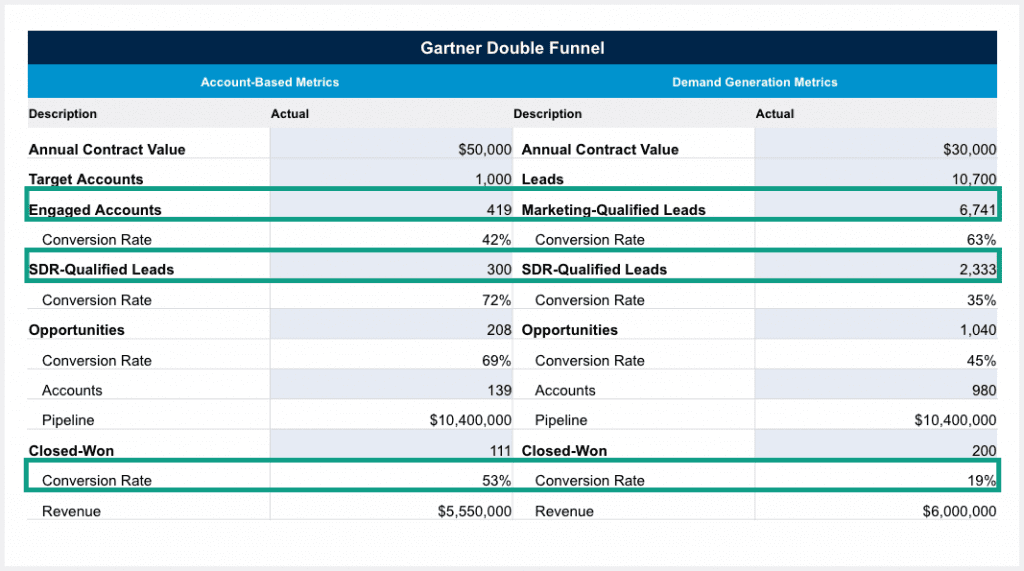
With ABM, our first performance metric is engaged accounts. What counts as engagement?
That’s subjective, but it must be some form of meaningful interest in your products or services.
Impressions, clicks, website visits — those don’t count as meaningful engagement. Instead, look for things like visits to the pricing page, pricing requests, demo requests, etc.
Basically, you want to ask yourself what metrics tell you an account wants to talk to your sales team. Once an account shows engagement, it’s time to start focusing on contacts instead of accounts (you know, the real people that work there).
Conversely, on the demand gen side, the first performance metric is marketing qualified leads (MQLs).
At this point, SDRs must qualify both engaged accounts and MQLs. This is the unification point where our double funnel merges into a single funnel — with the same metrics for both ABM and demand gen.
There are a couple of key learnings from this B2B paid social benchmark data:
1. Stick it out beyond engagement. Using ABM is supposed to come with lower volumes, higher conversion rates and higher ASP. However, these benchmarks show conversion to an engaged account, our first ABM performance metric, is actually lower for ABM than demand gen. Some companies see this, get spooked and pull away from ABM before they’re able to realize the benefits.
But conversion rates to SQL, opportunities, and closed-won deals increase significantly with ABM versus demand gen. The lesson? It’s harder to get engagement with ABM, but once you do, it will pay off.
2. Your balance of ABM vs. demand gen has a big impact on your SDR team. The team only has to work 300 accounts on the ABM side to get to the same amount of revenue as working 2,300 on the demand gen side of the funnel. That’s some serious efficiency, which impacts your budget and ROI. It also means that these SDRs can get really specialized and sophisticated when it comes to bringing these accounts through the funnel.
Dig deeper to improve performance across the board
It’s the side-by-side comparison of the double funnel that provides the real magic — and you can use it to dig even deeper into your performance data than ABM vs. demand gen.
The goal is to directionally understand which levers are working for you within each framework and at each stage of the funnel, then make incremental improvements.
For example, the following data (examples only, not benchmarks) breaks down volume-based demand gen performance across channels. With this kind of side-by-side breakdown, it’s easy to see where to invest next, depending on what you’re trying to accomplish.
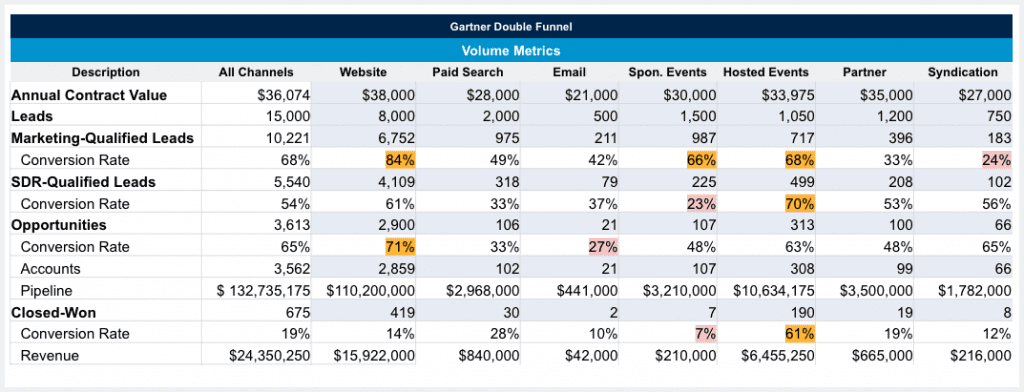
Say you are totally loaded up on MQLs, but you need to encourage more of them along into the SQL stage. Based on this data, it’s easy to see that you’d want to double down on website and events while ditching the syndication.
Look at as many slices of your data as possible:
- Which channels are performing?
- Are any campaigns knocking it out of the park (or tanking)?
- What gated content is working best?
Highlight the good stuff, and highlight the bad stuff.
The more slices you can examine, the more mastery you’ll have over your funnel, understanding how everything fits into and contributes to your performance.
But don’t get so hung up on measurement that you neglect the things that can’t be measured.
Podcasts. Word of mouth. Personal brands.
There are plenty of things that are important to building relationships and trust, but they’re nearly impossible to get a clear read on, performance-wise.
Use measurement as a guide, but make sure you still have the confidence to work on the meaningful things that aren’t measurable.
How to find the right ABM-demand gen balance
Most companies will need to find their own sweet spot when it comes to ABM vs. demand generation. Swinging too far one way or the other can completely tank your performance — and trust within your organization.
We’ve got a few tips for you if you find your pendulum too far off-center.
Too heavy on demand?
- Use as much data, intelligence and signals as possible to develop a strong ICP.
- Develop a small list of target accounts with definite reasons to buy.
- Build an MVP ABM program that spans teams, channels and activities to prove out and refine the use case.
- Use the double funnel to start hashing out what your split between ABM and demand gen should be.
Too heavy on ABM?
- Identify the channels and tactics that your buyers are most likely to respond to.
- Get a deep understanding of your prospects’ pain points, and develop messaging that creates urgency around those pain points.
- Create content that addresses the pain points.
- Test these messages and content by running high volumes of experiments to broad audiences. Determine which drive the highest engagement.
- Plug these findings into the double funnel to get a feel for what your ABM-demand gen split should be.
Infighting, anyone? How to address the obstacles
The double funnel is a simple concept, but it can still be difficult to align around. You’re going to face some obstacles. Maybe your boss wants you to go all in 100% on ABM. Maybe the sales and marketing teams are fighting over who gets credit for what.
The answer is:
- Get really good at measurement. Measure as many slices of data as possible throughout your funnel, and you’ll be able to offer data-driven responses to everyone’s crazy requests (and demands).
- Remember that good > perfect. Finding the right mix of ABM and demand gen — as well as all of the other tactics and channels beneath them — will be an iterative process. Create MVPs, get them out there, and learn from them fast. You should be looking for directional improvements rather than the perfect program out of the gates.
- Unify measures of success. Sales and marketing are on the same team, which means it doesn’t matter who gets credit for what. Unify measures of success between the groups to get everyone working together.
- Be wary of drastic swings. Letting your pendulum swing too far one way or the other will probably hurt your overall performance. Use the double funnel to keep an eye on balanced efforts and outcomes.
Let’s end with a marketing dad joke:
Why were the B2B marketer’s holiday gifts boring to look at?
Because he only used white paper.
Ba-dum, ching! 😆


